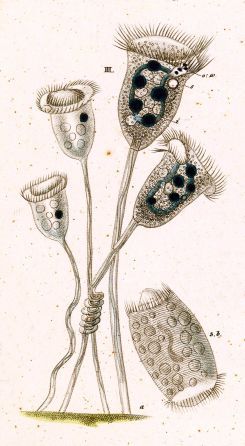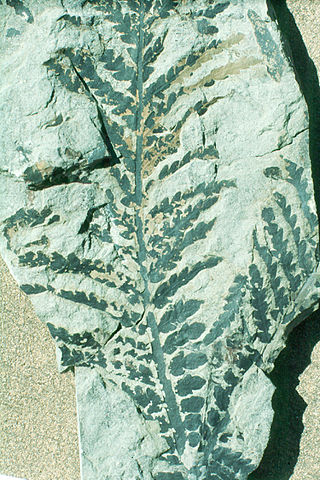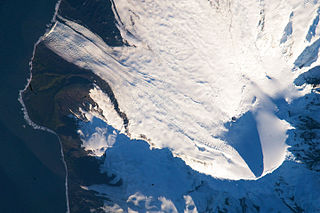The Mesozoic Era is the second-to-last era of Earth's geological history, lasting from about 252 to 66 million years ago, comprising the Triassic, Jurassic and Cretaceous Periods. It is characterized by the dominance of archosaurian reptiles, like the dinosaurs; an abundance of conifers and ferns; a hot greenhouse climate; and the tectonic break-up of Pangaea. The Mesozoic is the middle of the three eras since complex life evolved: the Paleozoic, the Mesozoic, and the Cenozoic.
The Permian is a geologic period and stratigraphic system which spans 47 million years from the end of the Carboniferous Period 298.9 million years ago (Mya), to the beginning of the Triassic Period 251.9 Mya. It is the last period of the Paleozoic Era; the following Triassic Period belongs to the Mesozoic Era. The concept of the Permian was introduced in 1841 by geologist Sir Roderick Murchison, who named it after the region of Perm in Russia.

The Permian–Triassicextinction event, also known as the End-Permian extinction event and colloquially as the Great Dying, forms the boundary between the Permian and Triassic geologic periods, and with them the Paleozoic and Mesozoic eras respectively, approximately 251.9 million years ago. It is the Earth's most severe known extinction event, with the extinction of 57% of biological families, 83% of genera, 81% of marine species and 70% of terrestrial vertebrate species. It is the largest known mass extinction of insects.

The lycophytes, when broadly circumscribed, are a vascular plant (tracheophyte) subgroup of the kingdom Plantae. They are sometimes placed in a division Lycopodiophyta or Lycophyta or in a subdivision Lycopodiophytina. They are one of the oldest lineages of extant (living) vascular plants; the group contains extinct plants that have been dated from the Silurian. Lycophytes were some of the dominating plant species of the Carboniferous period, and included the tree-like arboresencent lycophytes, some of which grew over 40 metres (130 ft) in height, although extant lycophytes are relatively small plants.

Osmundaceae is a family of ferns containing four to six extant genera and 18–25 known species. It is the only living family of the order Osmundales in the class Polypodiopsida (ferns) or in some classifications the only order in the class Osmundopsida. This is an ancient and fairly isolated group that is often known as the "flowering ferns" because of the striking aspect of the ripe sporangia in Claytosmunda, Osmunda, Osmundastrum, and Plensium. In these genera the sporangia are borne naked on non-laminar pinnules, while Todea and Leptopteris bear sporangia naked on laminar pinnules. Ferns in this family are larger than most other ferns.
Cryolophosaurus is a genus of large theropod dinosaur known from only a single species Cryolophosaurus ellioti, from the early Jurassic of Antarctica. It was one of the largest theropods of the Early Jurassic, with the subadult being estimated to have reached 6–7 metres (20–23 ft) long and weighed 350–465 kilograms (772–1,025 lb).

The Rhynie chert is a Lower Devonian sedimentary deposit exhibiting extraordinary fossil detail or completeness. It is exposed near the village of Rhynie, Aberdeenshire, Scotland; a second unit, the Windyfield chert, is located some 700 m away. The Rhynie chert contains exceptionally preserved plant, fungus, lichen and animal material preserved in place by an overlying volcanic deposit. The bulk of the Devonian fossil bed consists of primitive plants, along with arthropods, lichens, algae and fungi.

Marchantiales is an order of thallose liverworts that includes species like Marchantia polymorpha, a widespread plant often found beside rivers, and Lunularia cruciata, a common and often troublesome weed in moist, temperate gardens and greenhouses.

The Early Triassic is the first of three epochs of the Triassic Period of the geologic timescale. It spans the time between 251.902 Ma and 247.2 Ma. Rocks from this epoch are collectively known as the Lower Triassic Series, which is a unit in chronostratigraphy.

In the geologic timescale, the Olenekian is an age in the Early Triassic epoch; in chronostratigraphy, it is a stage in the Lower Triassic series. It spans the time between 251.2 Ma and 247.2 Ma. The Olenekian is sometimes divided into the Smithian and the Spathian subages or substages. The Olenekian follows the Induan and is followed by the Anisian.

Vorticella is a genus of bell-shaped ciliates that have stalks to attach themselves to substrates. The stalks have contractile myonemes, allowing them to pull the cell body against substrates. The formation of the stalk happens after the free-swimming stage.

The Hanson Formation is a geologic formation on Mount Kirkpatrick and north Victoria Land, Antarctica. It is one of the two major dinosaur-bearing rock groups found on Antarctica to date; the other is the Snow Hill Island Formation and related formations from the Late Cretaceous of the Antarctic Peninsula. The formation has yielded some Mesozoic specimens, but most of it is as yet unexcavated. Part of the Victoria Group of the Transantarctic Mountains, it lies below the Prebble Formation and above the Falla Formation. The formation includes material from volcanic activity linked to the Karoo-Ferar eruptions of the Lower Jurassic. The climate of the zone was similar to that of modern southern Chile, humid, with a temperature interval of 17–18 degrees. The Hanson Formation is correlated with the Section Peak Formation of the Eisenhower Range and Deep Freeze Range, as well as volcanic deposits on the Convoy Range and Ricker Hills of southern Victoria Land.
The Fremouw Formation is a Triassic-age rock formation in the Transantarctic Mountains of Antarctica. It contains the oldest known fossils of tetrapods from Antarctica, including synapsids, reptiles and amphibians. Fossilized trees have also been found. The formation's beds were deposited along the banks of rivers and on floodplains. During the Triassic, the area would have been a riparian forest at 70–75°S latitude.

The evolution of fungi has been going on since fungi diverged from other life around 1.5 billion years ago, with the glomaleans branching from the "higher fungi" (dikaryans) at ~570 million years ago, according to DNA analysis. Fungi probably colonized the land during the Cambrian, over 500 million years ago,, and possibly 635 million years ago during the Ediacaran, but terrestrial fossils only become uncontroversial and common during the Devonian, 400 million years ago.

Gondwana was a large landmass, often referred to as a supercontinent, that formed during the late Neoproterozoic and began to break up during the Jurassic period. The final stages of break-up, involving the separation of Antarctica from South America and Australia, occurred during the Paleogene. Gondwana was not considered a supercontinent by the earliest definition, since the landmasses of Baltica, Laurentia, and Siberia were separated from it. To differentiate it from the Indian region of the same name, it is also commonly called Gondwanaland.

Dicroidium is an extinct genus of fork-leaved seed ferns that were widely distributed over Gondwana during the Triassic. Their fossils are known from South Africa, the Arabian Peninsula, Australia, New Zealand, South America, Madagascar, the Indian subcontinent and Antarctica. They were first discovered in Triassic sediments of Tasmania by Morris in 1845. Fossils from the Umm Irna Formation in Jordan and in Pakistan indicate that these plants already existed in Late Permian. Late surviving members of the genus are known from the Early Jurassic (Sinemurian) of East Antarctica. Within paleobotany, Dicroidium is a form genus used to refers to the leaves, associated with ovuluate organs classified as Umkomasia and pollen organs classified as Pteruchus, while Dicroidum is also used collectively to refer to the whole plant.
Santa Juana Formation a Late Triassic sedimentary rock formation near Santa Juana in the lower course of the Biobío River in south-central Chile. Lithologies range from conglomerate sandstone, arkosic sandstone, siltstone and mudstone.

The Mawson Formation is a geological formation in Antarctica, dating to roughly between 182 and 177 million years ago and covering the Toarcian stages of the Jurassic Period in the Mesozoic Era. Vertebrate remains are known from the formation. The Mawson Formation is the South Victoria Land equivalent of the Karoo Large Igneous Province in South Africa, as well the Lonco Trapial Formation and the Cañadón Asfalto Formation of Argentina.
The Umm Irna Formation is a geological formation in Jordan. It is found in several outcrops in Jordan in the area around the eastern shore of the Dead Sea. It is Late Permian in age, and is the oldest unit in the succession, overlying the Cambrian aged Umm Ishrin Sandstone Formation. The formation predominantly consists of sandstones, claystones and mudstones deposited in fluvial and lacustrine conditions. The formation is of considerable paleobotanical interest, as it preserves the earliest known remains of plant groups that would become widespread during the Mesozoic, including Corystosperm seed ferns, represented by the widespread Triassic genus Dicroidium, cycads, podocarp conifers, as well as Bennettitales. Other plant groups present in the formation include Noeggerathiales, gigantopterids, lyginopterids and possible ginkgophytes.
Nilssoniopteris is an extinct form genus of leaves belonging to the Bennettitales. Leaves are slender and often entire-margined (smooth-edged), though some species have dissected leaves with numerous small segments extending down to the rachis of the leaf. Nilssoniopteris-like leaves are distinguished by their syndetocheilic stomata, indicating bennettitalean affinities. Similar "taeniopterid" leaves are placed in the genus Nilssonia if their stomata are instead haplocheilic, or Taeniopteris if the cuticle is not preserved.












